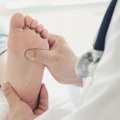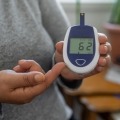Teenager Just Diagnosed with Type 2 Diabetes: What Do My Patients Ask?
By Francine Kaufman
 By Francine R. Kaufman, M.D.
By Francine R. Kaufman, M.D.
Newly diagnosed with type 2 diabetes? Dr. Francine Kaufman answers some of the most commonly asked questions for teens with type 2 diabetes
Leer este artículo en español.
In the 1990s, pediatric endocrinologists began to see youth with type 2 diabetes. It was a new occurrence – prior to that, youth with type 2 represented less than 5% of the pediatric diabetes population, and all of a sudden it was 10%, 15%, 20% of new-onset patients, depending on location. I have now seen hundreds of youth and young adults diagnosed with type 2 diabetes. So, at that first moment when a young person is diagnosed with type 2 diabetes, what questions are typically asked?
QUESTIONING THE DIAGNOSIS:
-
Are you sure about the diagnosis of diabetes? The criteria for diagnosing diabetes are well established, with a random glucose value of 200 mg/dL or greater, a fasting glucose of 140 mg/dL or greater, or an A1C greater than 6.4%. If someone is not on medications that elevate their blood glucose, and not acutely ill with a serious illness (including COVID-19), there is little other than diabetes that can cause these high blood glucose levels. Combine this with the typical symptoms of diabetes occurring over the preceding days to weeks to months, and it becomes close to certain that the diagnosis is diabetes.
-
Are you sure it is type 2 diabetes? Type 2 diabetes is typically considered during adolescence (it is very rare before the teen years) if the person has a strong family history of diabetes, has excess weight, and has signs of insulin resistance – high blood pressure, high lipids, and darkening of the skin around the neck, arm pits, and other areas where the skin folds. For girls, type 2 diabetes is also associated with polycystic ovarian syndrome (PCOS). Although it is rare to see ketoacidosis in type 2 diabetes, it can occur occasionally in adolescents. Sometimes it is hard to differentiate type 1 from type 2, and sometimes it looks like there are elements of both.
QUESTIONS ABOUT THE CAUSE:
-
What caused type 2 diabetes? Type 2 diabetes is due to a combination of genes and environmental triggers that lead to insulin resistance – which means the insulin produced does not work in the tissues as would be expected. Therefore, the glucose levels become elevated. Unfortunately, we still don’t fully understand how all these factors work together to cause diabetes.
-
What did we do wrong? No one did any one thing wrong to cause type 2 diabetes. Type 2 diabetes is due to a complex interaction between genes and the environment. For many people, it is very hard to control their food environment and their ability to have adequate physical activity, and no one should be blamed for getting diabetes.
-
Could it have been prevented? There is strong evidence that lifestyle modifications can help prevent type 2 diabetes in youth. However, we need the school, the community, and the home to all work together to enable youth to have optimal nutrition and physical activity. People with type 2 diabetes risk factors should try to do everything they can to improve lifestyle and health, especially after the diagnosis.
QUESTIONS ABOUT WHAT TO DO NOW:
-
Do I have to take insulin? Insulin is usually used at the time of diagnosis to lower blood glucose. Then, other glucose-lowering medications can be added – and maybe insulin can be reduced or stopped. However, it is important to remember that insulin is still the most effective medication to lower glucose levels, and it may need to be continued or restarted again later on.
-
How do I learn how to take insulin and other glucose-lowering medications? You will learn how to administer insulin, how insulin works, the types of insulin, and how to adjust the dosages in a formal diabetes education program. You learn about the oral medications that can be used and how they work, and how they work when combined, in a formal diabetes education program. Diabetes education is imperative. Be sure you are getting taught in a formal education program that covers all the necessary topics – causes of high and low glucose and how to treat them, diabetes medications, how to balance activity, the nutrition plan, the sick day plan, psychosocial issues, avoiding complications, and more. Your diabetes educator will reinforce how important physical activity, weight management, and proper nutrition are as part of diabetes care. In that program feel free to ask all of your questions and be sure you understand the answers. The diabetes education program is taught by diabetes educators: nurses, dieticians, doctors, social workers/psychologists under the direction of your health care professional – a physician, nurse practitioner, or physician’s assistant trained in endocrinology.
-
What do glucose numbers mean? The desired glucose levels are between 70-180 mg/dL, and the goal is to have as many blood sugar readings in that range as possible. This is called the target range. Below 70 mg/dL is low, and below 54 mg/dL is very (dangerously) low. Above 180 mg/dL is high, and above 250 mg/dL is very (dangerously) high. Glucose levels are monitored by fingerstick blood glucose measurements or by monitoring with a continuous glucose monitor (CGM) that assesses glucose levels under the skin (called the subcutaneous interstitial space).
-
How can we ever manage this? You will learn to manage diabetes with the help of your diabetes management team. It takes time, commitment, and diligence – but it can be done. And remember, you aren’t alone – there is a huge diabetes community behind you – more than 30 million strong in the US alone.
QUESTIONING WHY THERE ISN’T A CURE:
-
Why isn’t there a cure? The cure for diabetes is linked to the prevention of diabetes. This is true for type 2 and type 1 diabetes. There are very impressive groups of research scientists and physicians around the world working on this problem, funded by the NIH, the JDRF, the ADA, and other international research institutions, including EASD and the European Research Council. Understanding the diabetes process in detail is required – but it is an extremely complex process that has yet to be cracked. However, much has already been discovered, and we are learning more every day.
QUESTIONS ABOUT THE FUTURE:
-
What do I do now? Being a youth or young adult with type 2 diabetes does not stop you from being amazing, famous, or whoever you want to be. Just like youth with type 1 diabetes, it does not stop you from realizing your dreams, traveling the world, or doing the job you want. So, the future holds what you choose if you commit to understanding how to manage diabetes and then keep managing it every day. You are the pilot of your diabetes; your diabetes team is there to help be your copilot, so use them as needed.
-
What happens down the road? Shortly after diagnosis, you will find out about all the advances and innovations that type 2 diabetes management holds – lifestyle programs with coaches, gadgets to help with activity and nutrition planning, apps that encourage and advise, flash and real-time CGM, insulin pumps, and a host of advanced glucose lowering treatments that help address high glucose levels. There have been tremendous advances in these classes of glucose lowering medications that target specific cells and receptors on cells to improve diabetes outcomes. The focus, however, is not just on glucose alone, but blood pressure and cholesterol management are also critical – and lifestyle management is key. You will learn about diabetes advocacy and the diabetes community. No doubt your life has changed, but you will find support and comfort in being part of a caring and giving community.
These are some of the common questions I have been asked over the years. Many of these questions are also asked by those with type 1 diabetes. You may have many more questions that you would like answered; never be reluctant to ask your questions and to use the many resources available in the diabetes community to get your answers – such as diaTribe, for a start! They publish a weekly email, and I’ve been on the diaTribe advisory board since 2006 – you will learn so much from them on food, exercise, insulin, technology, stress, sleep, and more! I also highly recommend Adam Brown’s book, “Bright Spots & Landmines,” as well as the host of books published by the ADA.
 This article is a part of a series to support people newly diagnosed with diabetes funded in part by the Ella Fitzgerald Charitable Foundation.
This article is a part of a series to support people newly diagnosed with diabetes funded in part by the Ella Fitzgerald Charitable Foundation.







